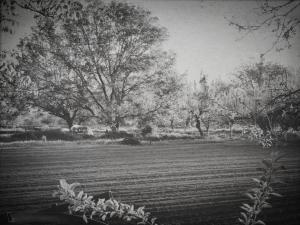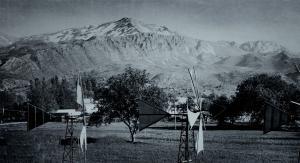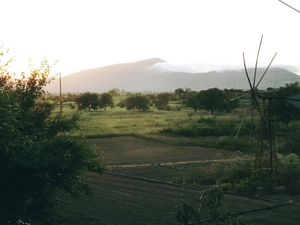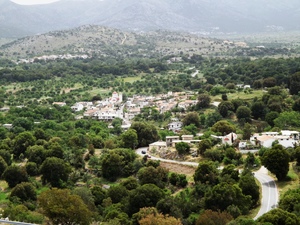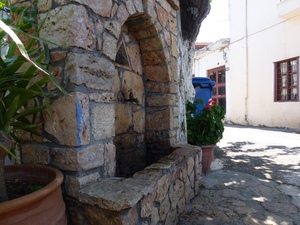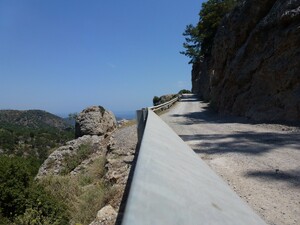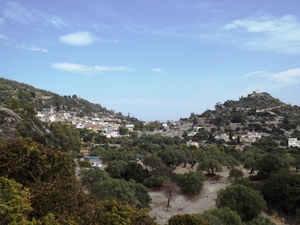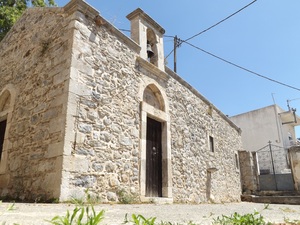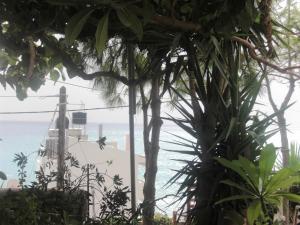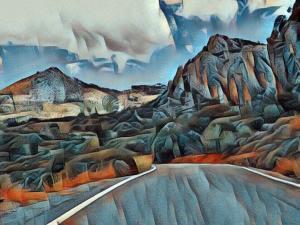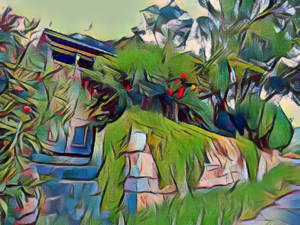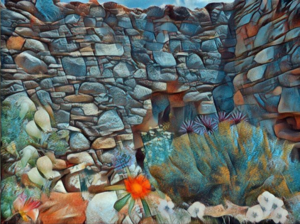9.0 Lassithi- Kritsa- Kroustas- Mirtos | 92 km | 1.642 Vertical meters | Category 2
I’m not feeling very well – I need a doctor immediately. Ring the nearest golf course. [Groucho Marx]
Imagine you have arrived at a remote hotel on the Lassithi plateau after a challenging climb high up into the mountains. It is a silent night. No sounds from the plain and the houses enter the room. Fog hovers above the fields and gardens all around. No bird sings, no dog barks, and no engine noise hums in the pitch-black night.
Frost At Lassithi: On this day in late October, everything is enveloped in frost. It’s such a cold night that you’ve donned all your warming clothes. The long thermal underpants, the fleece shirt, and also the two pairs of socks. That’s all the weight-optimized contents of your backpack will give you. Tightly wrapped up in the sheet and the wool blanket, you reach but a twilight sleep from which you wake up freezing again and again.
The Unexpected Guest: Until suddenly the door to your room opens, and a stranger staggers towards your bed. He wriggles out of his jacket and shirt and is about to undo his belt to get rid of his pants. There is no doubt, the aim of all these efforts is to find your bed! In no time you jump up to your feet, and in the dull neon light of the ceiling lamp, you face a complete stranger, who does not seem to notice you, while his clammy fingers proceed to unbuckle his belt.
A scream that had somehow been delayed on its way to your vocal cords is now released and with a loud „Hey! Hey, what are you doing here? What on earth are you doing in my room?!“, you finally have your guest’s attention. A thread of saliva dangles from the corner of his mouth, winding further down through his shaggy beard. His gaze is expressionless, glassy, and fixed, and the few scraps of words he can speak show that your question leaves him also perplexed. His breath fills the room with the distillation fumes of a liquor factory.
God Moves In Mysterious Ways: On this cold night, God fancied to test me and stranded this traveler from somewhere in the Eastern Baltic in my room. Either I had not locked the door or the room keys in this hotel were universal. Anyway, the stranger continued to undress, so that we faced each other in our underpants – he in short, formerly white knickers, and I in sporty cycling shorts. Discreetly, I picked up his pants that had slipped down, pulled them back up to his waist, put one of his hands on the waistband, and squeezed his shirt and jacket under his other arm. Looking at him encouragingly, I pushed him out of the room into the hotel corridor and wished him a good night.
Satisfied, I noted that he made a beeline for the door to the neighboring room and rumbled inside.
Back in bed, I fell into a dreamless sleep, but it was short-lived. A loud thump, as if a heavy object had fallen over, a scream, and a whimpering „Help! Help!“ startled me again. The whimpering from the neighboring room continued, so I climbed out of my warm nest whether I liked it or not. Unsure of what else fate would have in store for me that night, I made my way to the neighboring room.
Medical Treatment At 3 a.m.: There, in the bathroom, I was presented with a naked casualty lying on the floor. Still holding the showerhead with the torn end of the shower hose in his hand, he tried to pick himself up out of a puddle of water and blood, but his supporting hand slipped again and again. It was pathetic to see, especially because he had pulled half the shower paneling into the abyss with him. Obviously, he had leaned his back against the filigree shower door and had then crushed into the room with it.
Well, it’s not for nothing that I have worked in the hospital for four years. I know how to deal with recalcitrant patients. Reaching under his arms from behind, I lifted him onto a chair and wrapped him in a large bath sheet. His wish to call a doctor at three o’clock at night was difficult to fulfill in this remote part of Crete. So, I reassured him, referring to my wealth of experience as a scout and my clinical training, and was soon back with the first aid bag to clean and doctor a harmless head laceration and a few cuts on his hand. Having no will of his own, he allowed all this to happen, and his well-formulated thanks showed that he had sobered up a bit.
Sleep was out of the question that night, but the sonorous snoring from the room next door at least indicated that my patient was well.
9.0 Lassithi- Kritsa- Kroustas- Mirtos | 92 km | 1.642 Vertical meters | Category 2 - THE TOUR
THE TOUR – 92 km | 1.642 vertical meters | Category 2
From The Lassithi- Plateau To The Pass: Early in the morning, as the sun was just rising above the mountain ridge, I stepped onto the metallic ribbon that is the road and watched the asphalt shimmer in the morning light and disappear in the early morning mist around the Lassithi plateau towards the southwest.
To get there, you start on a dead straight 2.5-kilometer stretch up to the monastery of Koimiseos Theotokou Krystallenias, turn left at the crossroads, head west via the village of Mesa Lassithi, and follow the wide, 5-kilometer arc to the north and up to the pass at 1,039 meters above sea level.
At The Race Track: You feel excitement, anticipation, and a thrill of joy – like a child at its first visit to the go-kart track at the fair. Everything is huge, and right in front of you, the race track stretches over hill and dale in wide figure eights. The ignition is on, the 11 HP Honda engine is cranked with the starter grip, and the choke is reset. Everything around you vibrates and roars. There is eerie suspense, and suddenly all that was static and lifeless just a moment ago is in motion and merges into a whizzing swirl of colors, accompanied by completely unfamiliar sounds like the squeaking and bumping of the car moving across the plank track and the smell of rubber abrasion and gasoline fumes.
This is an ecstatic dream, a speed rush. Here it is, right in front of you: the magnificent arena of the Cretan alpine mountains. Your tires are already whirring on the asphalt, the spokes swirling brightly through individual fans of sunlight.
The mountain crest featuring Mount Dikti [2,148m] and Mount Lazaros rises higher and higher out of the haze, and along the way gardens and fields flit by. All kinds of vegetables are grown here, including carrots and potatoes. Apples and peach trees line the path, and from the dissipating banks of fog, you can hear the roaring of an Ursus 3250 tractor plowing up the field.
Breathless like a skier on a steep slope, the biker dashes down the wide curves of the road at high speed. He clamps the jolting bike underneath him, leaning far toward the asphalt and almost touching the dangerous, slippery grit of the roadside, but he pulls it safely through the curve.
As I rush by the towns of Mesa Potamio, Rousakia, and Exo Potamio this morning, I see the bustling farmers, women waving at me from their juice and honey stall, and an old man, bent over his cane, relaxing in the kafenion. I make a full stop in the village of Zenia to return to a young boy for a hand slap. „Tour de France!“ he shouts, „Allez, Allez!“ I shout back. Moments later, I’m back on the magnetic ribbon of the road, going faster and faster downhill. For the past approximately 20 kilometers, I made a descent of almost 1,000 meters in altitude to the lowest point of the tour behind the village of Exo Lakonia and the technical university of Agiou Nikolau, where a sea of olive trees dominates the scenery.
To Lato And Kritsa: Keep to the right at the Y-fork behind the university, and you will enjoy a ride through the olive groves on a dead straight stretch across the plain before you proceed towards the southeast on an increasingly narrow road.
Continue straight ahead at the next crossroads, follow the signs for Lato and Kritsa, and proceed through the long s-shaped bend. Here, at the foot of the mountains, Tripolitza limestone and red marls mark the beginning of the ascent at a gradient of 10 %.
Providing a challenging climb through oak and olive groves, the road rises steeply for two kilometers. High above the vast plain, you’ll find the excavation site of the Doric city-state of Lato, whose foundation dates back to the late 8th century BC.
Lato – Administrative Information: Τ.Κ. 72051, Kritsa, Mirabello (Prefecture of Lasithi). Telephone: +30 28410 22462 – 28361 – 90511, Fax: +30 28410 25115, Email: efalas@culture.gr – Lato- Website
Impatiently, I get out of the saddle in Kritsa and dance on the pedals as I meander through the narrow streets and around idle groups of tourists.
At the village exit, the Tripolitza limestones of the eastern flank of Mount Varsami and Mount Katharo Tsivi [1,664m] which you have driven around from Lassithi in a wide sweep to the east, rise high above the village. Turn left at the crossroads and head south to the village of Kroustas.
Up To Kroustas: The wide curves of the road leading up to the village of Kroustas [520 meters above sea level] feature gradients of 5-8%. At first, they are lined with fine-grained crystalline of the Upper Cretaceous, then with slate and folds in the limestone (Prina Complex).
As you enter the village on a shady avenue of plane trees, you have completed half of the distance. Some 45 km more to go, and you’ll reach the south coast at Mirtos. Time to fill up the water bottles at the tap in the center and enjoy a Double Greek Coffee with lots of sugar and ice-cold water from a carafe in the kafenion.
The route from Kroustas to the village of Prina is a quick ten-kilometer downhill ride through hilly terrain with oak woods, olive tree terraces, and shady pine groves.
Yellow broom, large cistus, sage, and spurge bushes bloom, myrtle and laurel line the path, and amazing giant thorny gorse bushes glow golden in the sunlight. In between, you can take in the breathtaking sweeping view across the south coast, all the way to the sea at Ierapetra and the Bramiana reservoir.
Prina To Males And Mirtos: From the village of Prina, the route climbs again for 15 kilometers. Featuring an average gradient of 5% and three terrain levels with fine-banked Miocene limestones, marls, sandstones, and conglomerates, it takes you through the villages of Kalamafka and Anatoli [at 340m asl] and to the pass ridge at 675 meters above sea level.
For the remaining six kilometers to the village of Males, one of the most beautiful roads in Europe lies ahead of you. The Tripolitza limestone flanks of Mount Megali Koryfi and the Trapeze Mountains rise high into the sky above you. The soft landscape forms around the road and towards the sea feature Miocene conglomerates, marls, and thin-banked limestones.
Revealing a new view of this fairy-tale landscape behind each curve, the road winds uphill and downhill through the stock of pine trees and the Centaurea spinosa, lavender, spurge, and dwarf juniper that make up the macchia of the south coast.
Every new bend, every range of hills, every turn provides stunning views across the foreland of Mount Dikti with its steep rock formations and the great blue of the sea.
Males: The vegetation indicates the abundance of water in this area. You can see oleander, juniper, and laurel at the roadside, orchards and vegetable gardens, and small fields for olive culture and winegrowing. Soon, the village of Males comes into view, beautifully situated above the valley of Mirtos at 600 meters above sea level.
In the village itself, a trip through the narrow streets is worthwhile. Walk up to the little church Panagia Messochoritissa and admire its frescoes dating from 1413. Above the village, wild vines, fig trees, and fruit trees make up the picture-postcard scenery of the south coast and the sea at Mirtos.
At the village exit of Males, the winding road descends steeply into the water-rich valley. The irrigation pipes gurgle and hiss from the bushes as you ride through the dense olive groves and cross the Mirtos River until you reach the entrance to the Sarakina Gorge. Continue through the village of Mirthi until you get to the main road (Ierapetra-Ano Viannos) and turn left to ride down to the beach village of Mirtos.

THE SECRET GARDEN
There is one character, however, who is truly timeless – he was there in the Stone Age, Bronze Age, and all the ages since; he can be seen today and every day in the villages around Crete. On his back he carries a huge load of sticks, some of which he unknowingly deposits from time to time on the path behind him as he walks, so that his journey becomes longer his load becomes easier. One wonders how many sticks will be left when he reaches his destination … [John Atkinson – A Small-Scale Reconstruction of the Settlement at Myrtos Phournou Koryphi – ΣΤΕΓΑ: The Archaeology of Houses and Households in Ancient Crete, American School of Classical Studies at Athens, Princeton N.J.]
Just like the inconspicuous little church, which greets you in immaculate white after a long journey, shining familiarly from the height into the valley. Just like the houses of the distant village, dancing like little bright butterflies in the shimmering heat over the street. Just as the harbor welcomes the fisherman to the shore of his home after a long journey over the salty seas and the moving waves, a Honda F400 single-axle tractor with a trailer shone through the green of the street trees like a lantern – a well-acquainted friend from childhood days.
With its 5 hp single-cylinder four-stroke engine, this faithful companion of every mountain farmer is famous for its excellent cross-country mobility, maneuverability, and the possible use of a wide range of additional equipment.
A wonderful smell of oil, gasoline and hot rubber emanated from the tractor. Infatuated, I climbed into the seat as the driver. And so it happened that I simulated the exit with humming lips, imitating the engine noise and eagerly shifted gears to simulate the driving experience, while unnoticed by me, the owner stepped out of the neighboring olive grove into the street behind me .
Despite the load of sticks and firewood on his back, his facial expression clearly showed his astonishment at my vocal interest in his vehicle.
The scene was unsurpassed in its full scope of embarrassment. There the Cretan farmer in a battered woolen shirt, solid jerkin and traditional black Cretan pants tucked into his long gumboots, facing me, an infantile biker in a loud, colourful Tour-de-France jersey, who had just climbed on the bench of his tractor, humming loudly and fumbled around with the adjusting levers of this technical masterpiece.
It would be better to spread a merciful cloak of oblivion over this incident.
He slowly turned around, waved to me with an inviting gesture and shouted „Ελάτε να σας διασκεδάσουμε – Come on, so we can entertain you“. This was an extremely clever move to get someone obviously mental dissconfused away from his tractor.
I usually avoid such invitations with all sorts of excuses. There is still a long way to go, it will soon be dark, my family is expecting me and the like. But today I gladly accepted the generous offer in order to straighten out the image of mental disorder that had emerged.
So I got to know Stamatis and together we walked up the sandy path to his house, situated on the hill below the mountain cliff and, surrounded by orange, fig, and almond trees. In the garden we sat in front of his little summer house with a fireplace, gas stove, tables and chairs, beautifully woven blankets on two stone benches and all sorts of old-fashioned cookware hung on the wall and enjoyed olives, hot peppers, stuffed vine leaves, small meatballs, bread and wine.
The family originates from a mountain village north of the Nida Plateau, and Stamatis had been the shepherd of a flock of more than a hundred sheep there in his younger years. In the 1980s, when there were no longer enough men in the family to herd and protect the flock, he purchased several fields on the plain towards Rethimno, became a farmer, and attained certain prosperity due to his diligence.
Later on, their children moved south to Ierapetra, and Stamatis and his wife chose the little house high above the plain of the south coast as their retirement home. The air is bad and the south wind harmful, he says, but the family and grandchildren visit them frequently now, and Stamatis grows all kinds of vegetables and some wine. Some chickens and four goats keep them company, and his old Toyota pickup truck is parked in front of the house.
The remaining route to my destination, the village of Mirtos, was manageable and leads mainly downhill. Thanks to my hasty departure from Lassithi at dawn, it was only early afternoon, so I sat back and relaxed, enjoying the great Cretan hospitality, the conversation with the old couple (gesticulating with our hands and feet), and their daughter’s funny comments.
The Secret Garden: Preparing to leave, Stamatis beckoned me to the rear part of the garden, which is adjoined by massive natural stone walls of former, now ruined buildings. A small gate led into the ruins and here a fairytale garden revealed itself, in which the individual, open rooms were planted with the most beautiful Mediterranean flora.
First we approached the remaining window cave in the room to the north and breathed in the cold, clear air of the Megalo Koryfi and the Trapeza mountains. The mountain cliffs towered high in front of us. Gorse, laurel, juniper, lavender and myrtle rose above a purple-violet carpet of decaying blossoms, their appearance appropriate to the barreness of this mountain slopes, modest in their grace and simple beauty.
The second room was brimming with glowing bougainvillea, a fig tree and Mediteranean spurge. Just as we stepped up to the rudimentary window cave to the west, a sudden strong gust of wind pushed us back. Zeus sent a stormy wind down from the Dikti mountains. It scattered the blossoms of the bougainvilla, rushed through the leaves of the rockrose, the mastic and the ferns, rustled in the bushes and grasses and then slipped out the door in a whisper. A rumble of thunder followed, and the dark clouds of an approaching thunderstorm towered above the demolished roof of the ruin.
Heading south now, we immersed ourselfs in the blue depths and the haze of the sea. The warm air within the south room of the ruin was heavy with the scent of the loquat blooming here. A murmur, a rustle and a crackle out of the now impenetrable mist made us shiver. There we were, standing by a swamp from which a tropical rainforest with Carboniferous dragonflies and amphibians was growing. Hissing cockroaches came out of the the ground. A millipede, in search of a tasty meal, snaked its way out of the shade of horsetail and mosses through the rainforests undergrowth. And on the ground, in the moss, under the wide fronds of ferns, scorpions and spiders lurked. We slipped away with a shudder.
The east room of the ruins embraced us with warmth and the scent of rosemary. Delicate cyclamen flourished in the shelter of the ruins. We leaned comfortably against the warm stone walls by the window. But the walls grew warmer, no, hot, hotter, blazing hot and spat out ants, thousands of black long-legged soldiers came out of the rock crevices to attack and torment us. We tried to speak, but the tongue was stuck to the dry roof of the mouth, not even a gargle could be elicited from the parched throat – enough. The way back was cut off by the thorns of a fast growing firethorn hedge. Our clothes torn, scratches on arms and legs, bleeding and with burning skin, we made our way to the door and escaped out of the haunted building.
Stamatis looked at me triumphantly. „Well – this is my garden“.






























